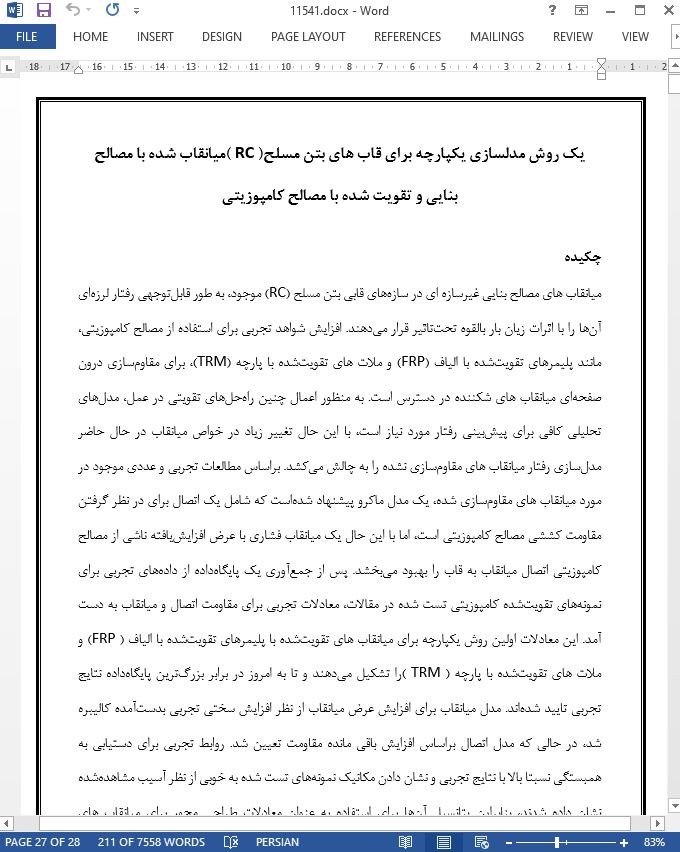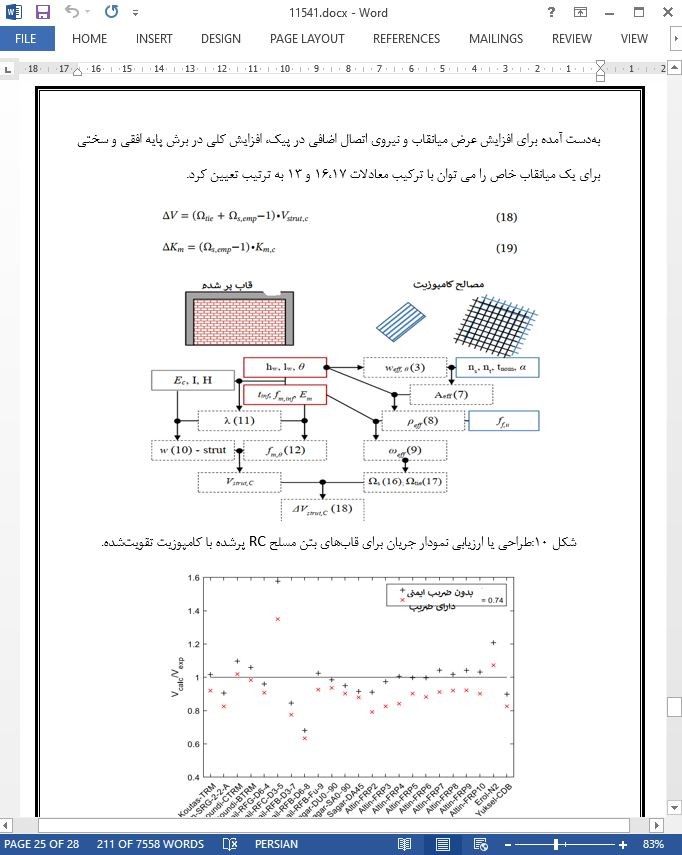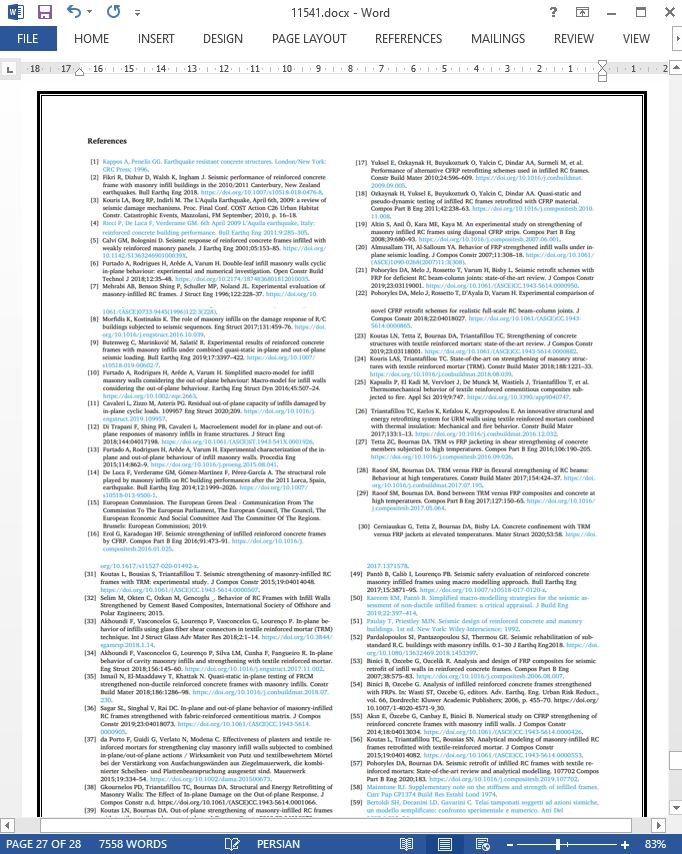
یک روش مدلسازی یکپارچه برای قاب های بتن مسلح ( RC ) میانقاب شده با مصالح بنایی
چکیده
میانقاب های مصالح بنایی غیرسازه ای در سازههای قابی بتن مسلح (RC) موجود، به طور قابلتوجهی رفتار لرزهای آنها را با اثرات زیان بار بالقوه تحتتاثیر قرار میدهند. افزایش شواهد تجربی برای استفاده از مصالح کامپوزیتی، مانند پلیمرهای تقویتشده با الیاف (FRP) و ملات های تقویتشده با پارچه (TRM)، برای مقاومسازی درون صفحهای میانقاب های شکننده در دسترس است. به منظور اعمال چنین راهحلهای تقویتی در عمل، مدلهای تحلیلی کافی برای پیشبینی رفتار مورد نیاز است، با این حال تغییر زیاد در خواص میانقاب در حال حاضر مدلسازی رفتار میانقاب های مقاومسازی نشده را به چالش میکشد. براساس مطالعات تجربی و عددی موجود در مورد میانقاب های مقاومسازی شده، یک مدل ماکرو پیشنهاد شدهاست که شامل یک اتصال برای در نظر گرفتن مقاومت کششی مصالح کامپوزیتی است، اما با این حال یک میانقاب فشاری با عرض افزایشیافته ناشی از مصالح کامپوزیتی اتصال میانقاب به قاب را بهبود میبخشد. پس از جمعآوری یک پایگاهداده از دادههای تجربی برای نمونههای تقویتشده کامپوزیتی تست شده در مقالات، معادلات تجربی برای مقاومت اتصال و میانقاب به دست آمد. این معادلات اولین روش یکپارچه برای میانقاب های تقویتشده با پلیمرهای تقویتشده با الیاف ( FRP) و ملات های تقویتشده با پارچه ( TRM )را تشکیل میدهند و تا به امروز در برابر بزرگترین پایگاهداده نتایج تجربی تایید شدهاند. مدل میانقاب برای افزایش عرض میانقاب از نظر افزایش سختی تجربی بدستآمده کالیبره شد، در حالی که مدل اتصال براساس افزایش باقی مانده مقاومت تعیین شد. روابط تجربی برای دستیابی به همبستگی نسبتا بالا با نتایج تجربی و نشان دادن مکانیک نمونههای تست شده به خوبی از نظر آسیب مشاهدهشده نشان داده شدند، بنابراین پتانسیل آنها برای استفاده به عنوان معادلات طراحی محور برای میانقاب های تقویتشده کامپوزیتی نشان داده شد.
6. نتیجهگیری
یک مطالعه در مورد روش مدلسازی کلان مبتنی بر طراحی یکپارچه برای قابهای بتن مسلح RC میانقاب شده با مصالح کامپوزیتی ارائه شد. نشانداده شدهاست که مواد ولایه های مختلفی به صورت تجربی آزمایش شدهاند و نتایج تقویت رضایتبخشی را به همراه داشتهاند. آسیب به میانقاب ها را می توان به میزان قابلتوجهی کاهش داد و نیروهای جانبی بزرگتری را می توان تحمل کرد. از نظر مدلسازی میانقاب های مقاومسازی شده، یک عبارت جدید برای افزایش عرض میانقاب فشاری به دلیل اتصال بهتر بین قاب و میانقاب پیشنهاد شد و همراه با یک اتصال کششی به کار گرفته شد.
با استفاده از یک پایگاهداده از نتایج تجربی جمع آوری شده برای این مطالعه، معادلات تجربی برای مدل میانقاب و اتصال تعیین شدند. در ابتدا، یک معادله تجربی برای افزایش عرض میانقاب براساس افزایش سختی سکانت برای نمونههای تست شده آزمایشگاهی پیشنهاد شد. براساس معادله جدید عرض میانقاب، یک اتصال کششی براساس افزایش مقاومت باقیمانده برای نمونههای آزمایشی تعریف شد. معادلات مربوط به میانقاب نرمال شده و مقاومت اتصال برحسب نسبت موثر ارماتور مکانیکی تعریف شدند. مدل پیشنهادی برای تولید مجدد یافتههای تجربی به خوبی از نظر افزایش مقاومت یافت شد. با این حال، برای معادلات تجربی مربوط به سختی میانقاب های مقاومسازی شده، برازش به طور قابلتوجهی بدتر بود.
Abstract
Non-structural masonry infills in existing reinforced concrete (RC) frame structures are known to affect their seismic behaviour significantly with potential detrimental effects. Increasing experimental evidence is available for the use of composite materials, such as fibre-reinforced polymers (FRP) and textile reinforced mortars (TRM), for in-plane retrofitting of brittle masonry infills. In order to apply such strengthening solutions in practice, adequate analytical models for predicting the behaviour are needed, however the large variation in infill properties already makes modelling the behaviour of non-retrofitted infills a challenge. Based on existing experimental and numerical studies on retrofitted infills, a macro-model is proposed, comprising a tie to account for the tensile strength of the composites materials, but also an increased compressive strut width due to the composite materials improving connection of the infill to the frame. After compiling a database of experimental data for composite retrofitted specimens tested in the literature, empirical equations for tie and strut strength was obtained. These equations constitute the first unified approach for FRP- and TRM-strengthened infills and were verified against the largest database of experimental results to date. The strut model was calibrated for the increase in strut width in terms of experimentally obtained stiffness increase, while the tie model was determined based on the remaining increase in strength. The empirical equations were shown to achieve a relatively high correlation with experimental results and to represent the mechanics of tested specimens well in terms of observed damage, hence indicating their potential for use as design-oriented equations for composite strengthened infills.
6. Conclusions
A study on a unified design-oriented macro-modelling approach for masonry-infilled RC frames retrofitted with composite materials was presented. It was shown that a variety of materials and layouts have been tested experimentally and yielded satisfactory strengthening results. Damage to the infills can be reduced significantly and larger lateral forces can be sustained. In terms of modelling the retrofitted infills, a new expression for compressive strut width increase due to a better connection between frame and infill was proposed and applied together with a tensile tie.
Using a database of experimental results gathered for this study, empirical equations for the strut and tie model were determined. First, an empirical equation was proposed for the strut width increase based on the increase in secant stiffness for experimentally tested specimens. Based on this new strut width equation, a tensile tie was defined based on the remaining strength increase for the experimental specimens. The equations for normalised strut and tie strength were defined in terms of the effective mechanical reinforcement ratio. The proposed model was found to reproduce experimental findings well in terms of the increase in strength. For the empirical equations relating to the stiffness of retrofitted infills, however, the fit was significantly worse.
چکیده
1. مقدمه
2. روشهای مدلسازی موجود
3. تعریف میانقاب و اتصال پیشنهادی برای میانقاب های مقاومسازی شده
1.1 تعریف میانقاب فشاری
3.2. سهم اتصال کششی
4. تنظیم معادلات مدلسازی تجربی
4.1. پایگاه داده تجربی
4.2. ارتباط بین پارامترهای تجربی و مدلسازی
4.3. افزایش در عرض میانقاب
4.4. معادله مقاومت اتصال تجربی
5. تحلیل ها و بحث
5. ۱ تحلیل کمی مدل تجربی پیشنهادی
5. ۲ تفسیر کیفی آسیب با استفاده از مدل پیشنهادی
5. ۳ روش طراحی مقاوم سازی ساده شده
6. نتیجهگیری
ABSTRACT
1. Introduction
2. Existing modelling approaches
3. Proposed strut and tie definition for retrofitted infills
3.1. Compressive strut definition
3.2. Tensile tie contribution
4. Calibration of empirical modelling equations
4.1. Experimental database
4.2. Correlation between experimental and modelling parameters
4.3. Increase in strut width
4.4. Empirical tie strength equation
5. Analysis and discussion
5.1. Quantitative analysis of the proposed empirical model
5.2. Qualitative interpretation of damage using the proposed model
5.3. Methodology for simplified retrofit design
6. Conclusions
- ترجمه فارسی مقاله با فرمت ورد (word) با قابلیت ویرایش، بدون آرم سایت ای ترجمه
- ترجمه فارسی مقاله با فرمت pdf، بدون آرم سایت ای ترجمه



